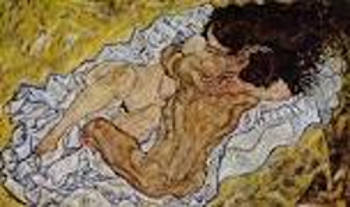CURATOR'S CHOICE SM
Exhibition Reviews
| Home | | Museum
Guide | | International |
| Theater |
| "Poetics of the Gesture: Schiele, Twombly, Basquiat" By Claire Taddei
The poetry of viscera. From May 2 to June 14, 2014 Nahmad Contemporary is presenting "Poetics of the Gesture: Schiele, Twombly, Basquiat," the first exhibition which attempts to examine the similarities between three of the most influential twentieth century artists of their respective generations, the Austrian expressionist Egon Schiele, the American postwar artist, Cy Twombly and the American neo-expressionnist Jean-Michel Basquiat. Curated by Dr. Dieter Buchhart, who has organized major exhibitions on artists such as Edvard Munch, Otto Dix, George Braque, Jean-Michel Basquiat and Keith Haring at institutions including the Foundation Beyeler, Munch Museet Oslo, Museum of Modern Art Copenhagen and the Musée d'Art Moderne de la Ville de Paris, this exhibition examines the new visual vocabulary created by Basquiat, Schiele and Twombly. Each artist is immensely personal but also intelligible to everybody. In this new exhibition, in which the majority of works are Basquiat's, the gestures are both divergent and similar. The epochs, aesthetic personalities and pictorial tensions differ, but an obsession with the body and movement rallies them. We notice a similarity in the starkness of the line, which is neither ornamented nor embellished. The intention is also similar, they painted in a sort of existential euphoria; their aesthetic is frenetic, visceral and passionate. The presentation of the artwork, and the works themselves, establish a dialectic between the curves and sinuosities of body and the turmoils of the flesh. The restless and strident stroke of Basquiat gives way to the labile curves of Schiele, to return to the more agressive, nervous line of Twombly. This exhibition can be understood as a gradation in body obliteration; little by little the body vanishes.
First, the body bubbles up with the bilious tension of Basquiat. The gesture is frozen in a dark aesthetic. The body is overflowing, as in an implosive or pre explosive state. The aesthetic is chaotic. Then, the sturdiness of this American neo expressionist gives way to the fluidity of the existential neurosis of Schiele. Here, the aesthetic of the portrait, a place of the solitude, differs from the aesthetic of sex, a place of symbiosis. The gesture of the portrait is psychotic, whereas the gesture in sex is more voluptuous. In these paintings by Schiele, sexuality appears as a catharsis, as if to ward off existential neurosis. But voluptouness soon mutates into fluidity and the curve becomes symbolic of ephemera and uncertainty. As in Basquiat's, there is in Schiele's paintings a real dichotomy between the outside and the inside of the body.
Finally, the fluidity of Schiele evaporates into to the obliterating frenzy of Twombly's drawings. There is no more outside or inside; here, either the body has exploded, leaving only disparate and shapeless pieces of breasts and genitals as organic shapes, or the body has definitely disappeared, giving way to the solitary and nervous line. In all cases, the line is curved in a compulsive way or straight in an abstract and minimalist style.
Among, Basquiat, Schiele and Twombly, bodies are brutalized, sex is constantly questioned, the symmetry is wrong and the fluctuations in bodily lines can be interpreted like all the uncertainties of reality. The exhibition ends with a juxtaposition of carefully chosen works of each artist. From Basquiat to Twombly, via Schiele, the density of the body disappears and the poetry of the gestures is exalted. The convergence between them is a shared exploration of transcendence and the human condition. This is poetic, a poetry from the guts. However, there is a more striking similarity between Basquiat and Schiele. Their curves converge more than they diverge. Expressiveness is concentrated into the hands and face which draw our focus. Color is used to distinguish the moods of the flesh, of the soul. We realize a strange similarity between the "Standing man" of Basquiat and Schiele's paintings of bodies. Futhermore, we note similarities in the life of the artists: instability, the role of women, drugs, being first exhibited at the same age, followed by a brilliant, dazzling and a too short career, and death at the same age of 28. Emotionally strong because it is aesthetically sublime, "Poetics
of the Gesture: Schiele, Twombly, Basquiat" leaves us wanting more.
Maybe it was due to a lack of his works or the choice of his works,
but, infortunately, the works exhibited by Cy Twombly are less striking
than Basquiat's and Schiele's. We would also have expected more of Egon
Schiele's canvases. We would have appreciated the opportunity to more
deeply savor the similarity between Schiele and Basquiat, which was
part of the stated purpose of the exhibition.
If you go:
|




